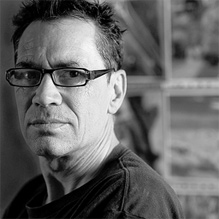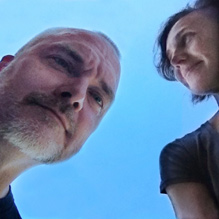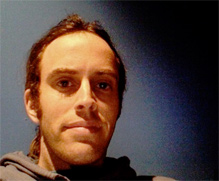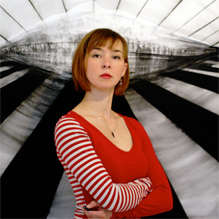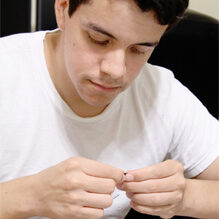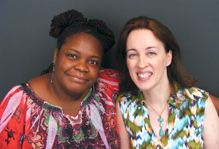Emergent Relations
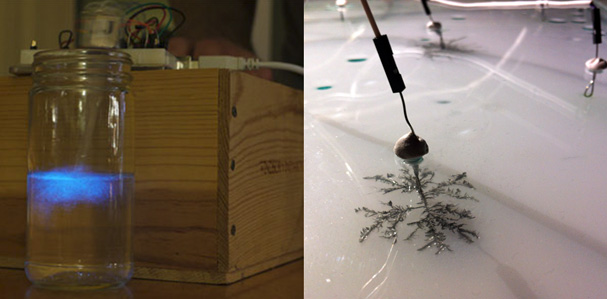
DPrime Research presents “Biopoeisis and the Biolesce” workshop. Biopoesis is a chemical computer. Biopoiesis is a series of experiments exploring the relationships between structure, matter, and self-organization. The goal is the development of autonomous computation and control systems in what can be described as a computational “primordial soup”. Biolesce brings together bioluminescent algae and physical computing in an ongoing series exploring the potential for the naturally occurring bioluminescence of the algae to be stimulated in a computing context. Both works challenge contemporary notions of technology and typical computing practices in their materials and in their hybrid practices inspired by art and science.
Biopoiesis/Biolesce: This combination of activities by DPrime Research explores the boundary between living and nonliving structures. By using computation to inject some sort of logic into chemical processes, Biopoiesis shows that a compound that is usually considered inorganic (stannous chloride) can exhibit crystalline growth patterns that mimic the patterns of living organisms, and that a self-regulating process of formation and decay occurs similar to what one sees in living things. Similarly, Biolesce explores the effects of computational logic on a colony of algae, to show that there is a level of information processing going on in plant life that is comparable to sensation in animals.
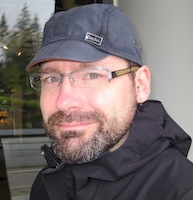
Tyler Fox
I’m Tyler Fox, an artist and PhD student at Simon Fraser University in Vancouver, British Columbia, Canada. I am part of the DPrime team which also includes Carlos Castellanas and Steve J. Barnes. Personally, I am interested in the unique ways that art can bring together technology and living organisms to create new experiences that would be impossible in other contexts.
Skills Applied
 ELECTROCHEMISTRY
ELECTROCHEMISTRY
 PHYSICAL COMPUTING
PHYSICAL COMPUTING
 STUDY OF BIOLUMINESCENT ALGAE
STUDY OF BIOLUMINESCENT ALGAE
ARTIST SUGGESTION
The Biolesece project pulls on different disciplines (biology, math, computer science to name a few) to understand how bioluminescence in algae works, how to keep the algae healthy, and how to use physical computing to stimulate the algae. By pulling together all of these fields, the project makes for a unique experience between the audience and the algae. It required learning about the building of microcontrollers (both projects), about bioluminescent algae (Biolesce) and about electrochemistry (Biopoiesis). We have spent a great deal of time going through publications about algae and electrochemistry. We have also spent a lot of time online looking at and doing tutorials for physical computing–both hacks and creative approaches to using technology. Hacks of existing technologies and parts have lead to innovative ways of dealing with some of the challenges we faced during the development of both of these projects. These are some approaches that students can try. Tyler
STEMarts Design Tool
Explore the site to come up with your idea. Pick an artist or topic.
This artist is one of 20 ISEA2012 artists featured in this curriculum. Explore them all to see which you would like to use as a model for your project. It could be a combination of different artists and topics that inspire the work. Print out the STEMArts Design Tool which outlines these steps and use it as a guideline in your process. Visit the Wiki-Resource on each artist page to see tutorials, activity ideas, read articles about the medium that the artists explored and other resources to help you find something that peaks your interest. Click on the Artist Interview button on each page to read a personal interview with each artist. The artist was asked questions to share their creative process, talk about the medium they work with, and to share tips and advice for you as you begin your design process. In this phase, you are looking for inspiration for an project that is meaningful to you. Get a journal and start sketching and writing notes on your process.
Brainstorm and come up with ideas for your art piece.
In this phase, you will need to sketch, doodle, contemplate, or journal, in order to start allowing ideas to formulate. Search the Wiki-Resource under keyword “brainstorming” to explore some techniques and articles. The artists in the Artists Interviews also share their personal brainstorming techniques. Read through all these resources and do some research yourself. Then set aside some daydreaming time and get started. Think big and let all the ideas you have hit the page without editing them. Get in the flow and write or draw in a journal any ideas you come up with that you would like to explore further.
How are you going to turn the idea into a reality? Research.
Brainstorming and researching go hand in hand. You will be going back and forth between the two until you come up with a plan. Once you brainstorm some great ideas for an art piece you will need to research to learn more about the topic or medium. In turn, that leads to more brainstorming. How are you going to turn the idea into a reality? What materials do you need? Can you build it yourself or will you need help? In your journal make a list of any questions or concerns that come to mind. Search the Wiki-Resource under the keyword “research tips” for ideas, and explore on your own to find the answers to your questions. If you need to collaborate on this piece, decide who that will be and make plans to work together.
Start your design plan.
You have everything you need now to start creating. Refer to your journal to review your process up until now. Review the STEMArts Design Tool. Research online if you still have a question about anything. Ask your teacher for help. Now, it´s time to make a materials list and sketch out your plan of action. Or perhaps you prefer to dig in and start building something? There are many ways to approach it and every artists has their own style. Each artist shared their own design approach in the interviews. Look back over them and see which approach suits your style. Start creating!
See how it works, test and re-test until you get what you want.
The design process always involves testing out your ideas in the real world, and building prototypes to see if it works. You also may find that once you start building it, it is not what you had in mind. This is part of the process. It helps to document everything you do in your journal. This is the hardest stage because it is easy to get discouraged. Read about what the ISEA2012 artists say about this phase. Ask for help when you need it. If you get stuck, go back to the brainstorming phase for new ideas. Get feedback from your teacher, your friends, and experts. We created a Troubleshooting Guide to help you evaluate and critique your work in case you are stuck on your design.
Practice presenting in order to get feedback for your finished piece.
You have probably explored options for presenting your work but this is the time to work out the details. Your venue will often determine the presentation format. Now is a good time to present your work to friends and peers to get some feedback. Our Feedback Survey poses questions that will help you critique your own work, and provides tips on receiving constructive feedback from others. It will also help to look back on your design process to see if you are where you want to be with your art piece.
Bringing it all together. Time to share it.
Sharing your work can be scary and thrilling at the same time. Hear what artists have to say about the importance of sharing their work with the public. Do you want to share it in your community? Is there a venue interested in what you have created? Will you use Vimeo, YouTube, a blog? Search under keyword “Share tools” in the Wiki-Resource for some links and ideas.
STEMarts Wiki
Search this open source wiki for links to learn more about the type of art that Tyler and the team at DPrime Research are exploring. You will find links to articles, images, video, tutorials and more. The purpose of this wiki is to provide a starting point for your research in creating an art piece or project inspired by DPrime Research. If you have find anything interesting on your own please consider sharing it in this open forum.
Remember the resource is an open forum sharing links and ideas that others have found – always check your sources and give credit where credit is due. The open source movement generously shares its knowledge and relies on users and sharers feedback – so if there’s something really good or doesn’t work let others know.
Adaptive Systems Bacteria Bacterial Communication Bio-feedback Bio-sensors Bio-technology BioArt Bioluminescence Biopoiesis Cybernetics Data Collection DPrime Research Elecronics Electrochemical Electronics Electronic Tagging Ethics Interactive Art Life Processes Microbes Mobile Media Performance Organism Physical Computing Physical Interaction Politics Programming Protyping VIEW ALL
NEXT GENERATION SCIENCE STANDARDS
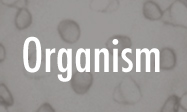
Core Idea LS1: From Molecules to Organisms: Structures and Processes
LS1.A: Structure and Function
LS1.B: Growth and Development of Organisms
LS1.C: Organization for Matter and Energy Flow in Organisms
LS1.D: Information Processing

